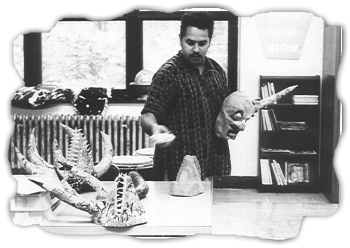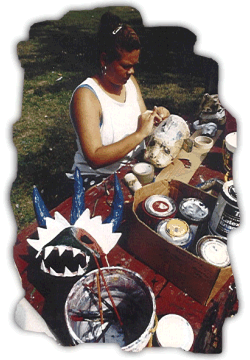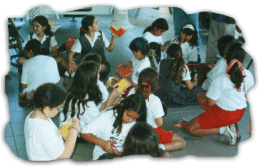.: Ken Melendez :.
.jpg) |
.jpg) |
 |
 |
A musical director, artisan, and a percussionist.
Born in 1969, in the city of New York Puerto Rican parents, Mrs. Flor de Maria
Padilla and Mr. Daniel Rodriguez Melendez, professional jockey author of the
victory over the great horse called Camarero.
At the age of seven he
moved to Ponce Puerto Rico, where he studied his first and second grades in the
city of Ponce, and later finish his other studies in the United States a
graduated of Southview high in 1988 and ex-student of Lorain County Community
College from 1989-1992.major in industrial design. He studied as a
percussionist with the teachers Jose Ortiz, Noel Quintana and Rafa Guzman and
others. He has also form parts of different folklore and popular music groups
such as Bambalue, Yoruba, Pedro Guzman and Su Cuatro Rumbero, Irving Cancel and
his jazz band, Conjunto la Perla and others.
In the area of arts,
Kenneth likes to create traditional masks with different material such as:
sack, coconut, wood, paper mache, gourd, foam, plastic, and wire mash. Reid
Wood, Leonardo Pagan and Miguel Perez were his art teachers. He has had
exhibition in the museum of El Barrio in New York, McDonough in Youngstown
Ohio, Esqueleto gallery Oberlin Ohio, in the Lorain County Community College
Gallery in Lorain Ohio, the jazz gallery in California, in the American History
Museum in the Smithsonian in Washington D.C., in the museum of Puerto Rican
culture to name a few. His emphasis is specially directed towards art and
music. He dedicated to travels out of Puerto Rico to demonstrate his work in
different organizations and schools in the United States. He also spend his
time showing Puerto Rican kids the importance of their heritages in music and
art, throughout different work shops.
He also came out in a video
called "American cultures for children" hosted by Phylicia Rashad about the
Puerto Rican heritage. The movie "Under Suspicion", and a documentary for
France.
Making A Vejigante Mask
|
Materials:
|
 |
Directions:
- First a cone shape mold is made from clay representing anything that comes to mind and set the clay mold to air dry for a few hours.
- Take the dry mold and cover it with aluminum paper. This will allow removal of the paper helmet with greater ease and prevent it from sticking to the clay mold.
- Make the paste (mix wheat flour with water, cook this mixture and use it as paste or mix water and wall paper paste an use this too as paste.)
- Place strips of paper with paste on top of the mold with aluminum paper, continue until desored thickness is reached.
- After removing the paper helmet from the clay mold, let dry for at least 24 hours until it dries and hardens.
- Once the paper helmet is dry, mark the eyes and mouth with a pen or marker, then proceed to cut with the knife the marked areas. The neck entrance must also be cut, if the mask is to be used. This last step can be omitted if the mask is a decoration piece.
- Use sandpaper to give final finishing touches and eliminate any irregularities.
 |
Horns:
|
 |
Painting:
|